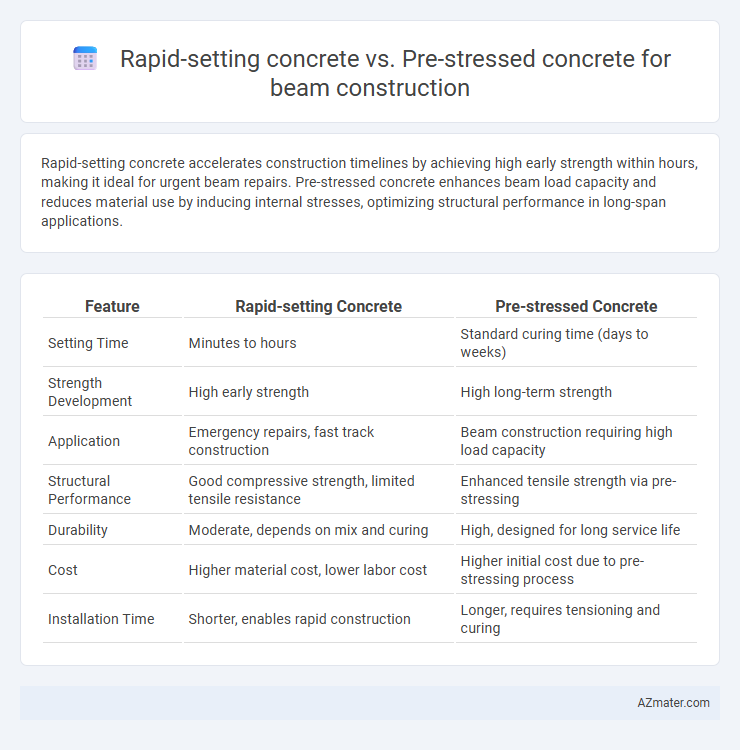Rapid-setting concrete accelerates construction timelines by achieving high early strength within hours, making it ideal for urgent beam repairs. Pre-stressed concrete enhances beam load capacity and reduces material use by inducing internal stresses, optimizing structural performance in long-span applications.
Table of Comparison
| Feature | Rapid-setting Concrete | Pre-stressed Concrete |
|---|---|---|
| Setting Time | Minutes to hours | Standard curing time (days to weeks) |
| Strength Development | High early strength | High long-term strength |
| Application | Emergency repairs, fast track construction | Beam construction requiring high load capacity |
| Structural Performance | Good compressive strength, limited tensile resistance | Enhanced tensile strength via pre-stressing |
| Durability | Moderate, depends on mix and curing | High, designed for long service life |
| Cost | Higher material cost, lower labor cost | Higher initial cost due to pre-stressing process |
| Installation Time | Shorter, enables rapid construction | Longer, requires tensioning and curing |
Introduction to Beam Construction Methods
Rapid-setting concrete accelerates the curing process, enabling faster project completion and early load-bearing capacity in beam construction. Pre-stressed concrete involves tensioning steel tendons within the beam before applying loads, enhancing structural strength and minimizing deflection under stress. Selecting between rapid-setting and pre-stressed concrete depends on project timelines, load requirements, and durability considerations.
Overview of Rapid-Setting Concrete
Rapid-setting concrete offers accelerated curing times, enabling quicker form removal and faster construction progress compared to traditional concrete. Its high early strength development makes it ideal for repairs and projects requiring minimal downtime. This concrete type typically contains specialized cementitious materials and admixtures that enhance hydration speed without compromising durability.
Fundamentals of Pre-Stressed Concrete
Pre-stressed concrete involves applying a pre-compression force to the beam through tensioned steel tendons, enhancing its load-bearing capacity and resistance to tensile stresses. Rapid-setting concrete, while beneficial for quick project turnaround, lacks the intrinsic reinforcement and stress distribution properties fundamental to pre-stressed concrete beams. The pre-stressing process fundamentally improves durability and structural efficiency by counteracting tensile forces that conventional or rapid-setting concrete alone cannot manage effectively.
Strength and Load-Bearing Capacity Comparison
Rapid-setting concrete achieves high early strength, reaching up to 20 MPa within the first hour, which accelerates construction schedules but typically attains lower ultimate strength compared to traditional mixes. Pre-stressed concrete beams, reinforced by tensioned steel tendons, offer superior load-bearing capacity, distributing stresses to prevent cracking and allowing spans up to 30% longer with higher durability. For structural applications demanding enhanced strength and long-term performance, pre-stressed concrete provides a more robust solution, whereas rapid-setting concrete suits urgent repairs and situations requiring quick turnaround.
Speed of Construction and Project Timelines
Rapid-setting concrete accelerates beam construction by reducing curing time to hours, enabling faster formwork removal and quicker project progress. Pre-stressed concrete beams, while requiring longer initial fabrication and tensioning processes, allow for longer spans and reduced beam depth, which can streamline erection and reduce overall project duration. Choosing between the two depends on balancing immediate speed of curing with the structural efficiency that pre-stressed beams provide for accelerated schedules.
Durability and Long-Term Performance
Rapid-setting concrete offers quick strength gain but may exhibit reduced long-term durability compared to pre-stressed concrete, which is engineered to handle tensile stresses and minimize cracking. Pre-stressed concrete beams benefit from enhanced durability through controlled crack widths and improved resistance to environmental factors, extending service life in demanding structural applications. Beam construction using pre-stressed concrete generally ensures superior long-term performance and structural integrity compared to rapid-setting concrete alternatives.
Cost Analysis: Material and Labor
Rapid-setting concrete significantly reduces labor costs by accelerating curing time, allowing faster project completion and minimizing formwork time in beam construction. Pre-stressed concrete involves higher material costs due to the use of high-strength steel tendons and specialized equipment required for tensioning, increasing initial expenses. Overall, rapid-setting concrete offers lower upfront labor expenses, while pre-stressed concrete entails higher material investments but can lead to cost savings in structural efficiency and long-term durability.
Application Suitability for Different Projects
Rapid-setting concrete is ideal for projects requiring quick turnaround times, such as emergency repairs and precast beams where early strength gain is essential. Pre-stressed concrete suits large-span beam construction in bridges, commercial buildings, and infrastructure requiring enhanced load-bearing capacity and reduced cracking. The choice depends on project scale, load demands, and time constraints, with rapid-setting favored for speed and pre-stressed for structural performance.
Environmental Impact and Sustainability
Rapid-setting concrete reduces construction time and energy consumption, minimizing CO2 emissions during the curing process, which enhances its sustainability profile. Pre-stressed concrete improves material efficiency by allowing longer spans with less concrete and steel, lowering overall resource use and environmental footprint. Both types contribute to sustainable construction, but pre-stressed concrete's extended durability and reduced material demand offer greater long-term environmental benefits.
Key Takeaways: Choosing the Right Concrete for Beams
Rapid-setting concrete offers faster curing times ideal for projects with tight schedules, while pre-stressed concrete provides enhanced load-bearing capacity and reduced cracking for long-span beams. Beam construction benefits from choosing rapid-setting concrete when speed is paramount, whereas pre-stressed concrete suits applications requiring higher structural performance and durability. Selecting the right concrete depends on project timeline, load requirements, and structural design considerations.

Infographic: Rapid-setting concrete vs Pre-stressed concrete for Beam construction
 azmater.com
azmater.com